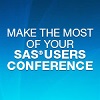
Having served as conference chair for last year’s SAS Global Forum, I am so looking forward to just being a normal attendee at this year’s conference in Washington, DC. That’s right, I’ll have no speaking commitments, no interviewers, no responsibilities—just the privilege of selecting the content that is right for










